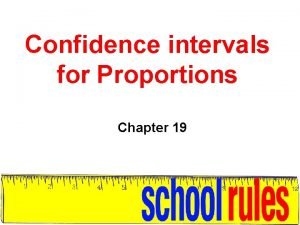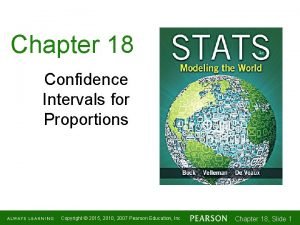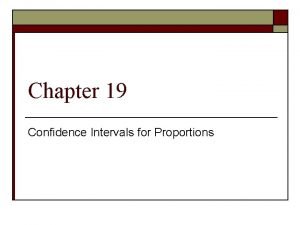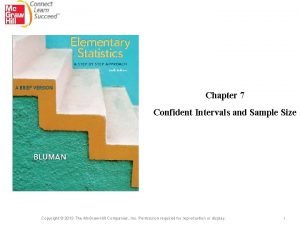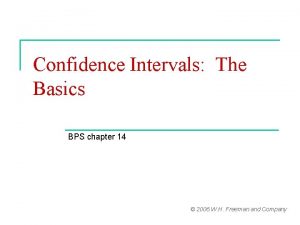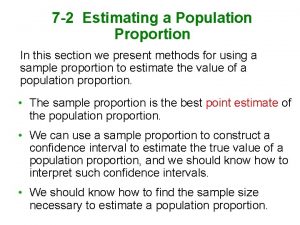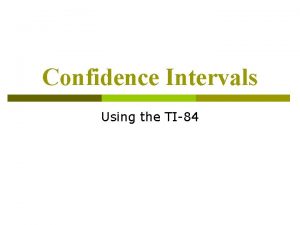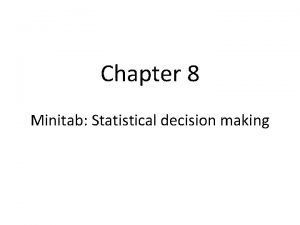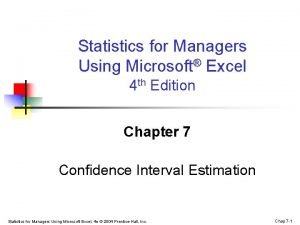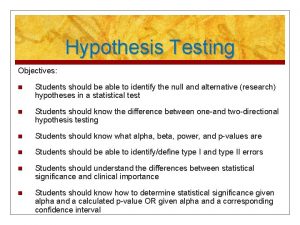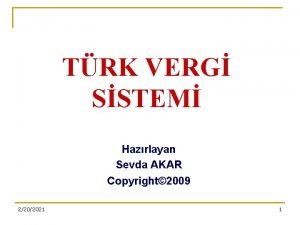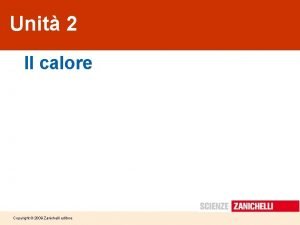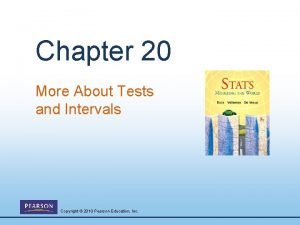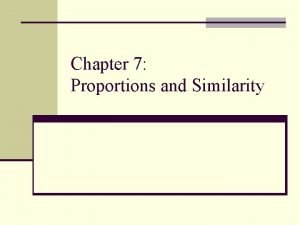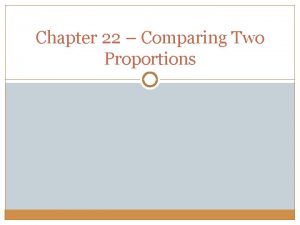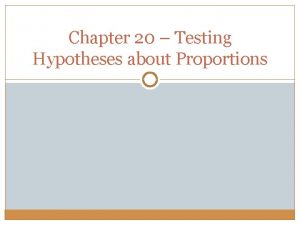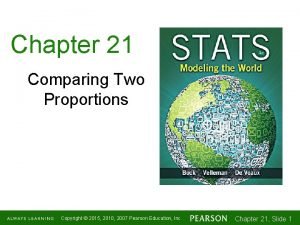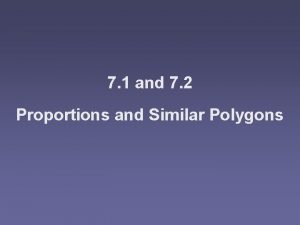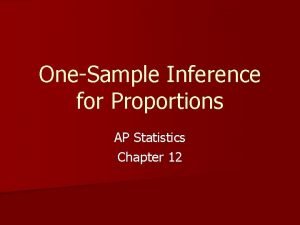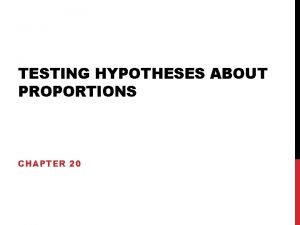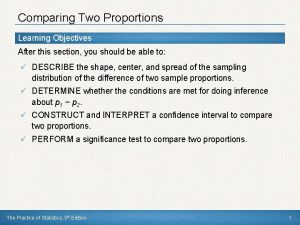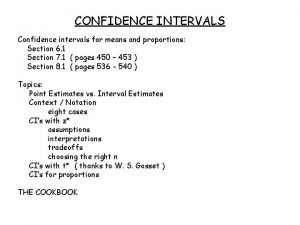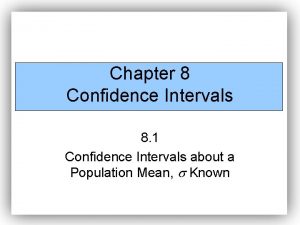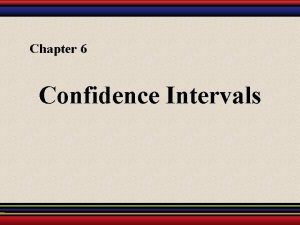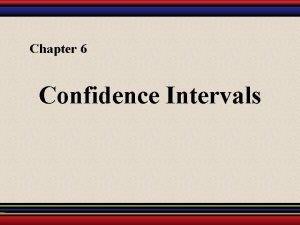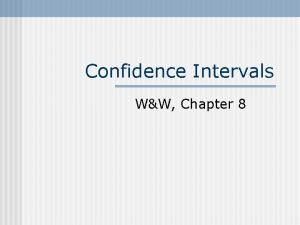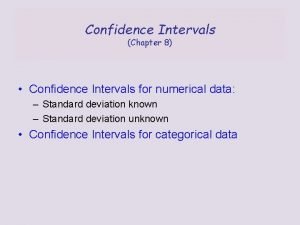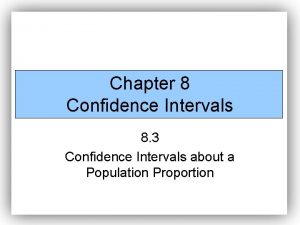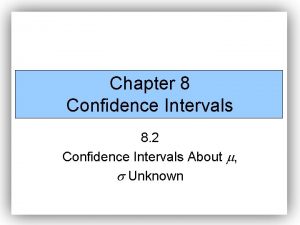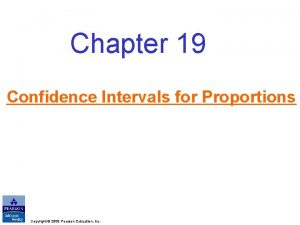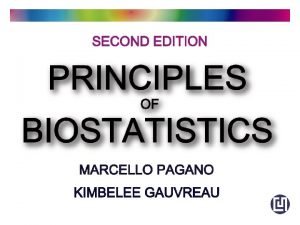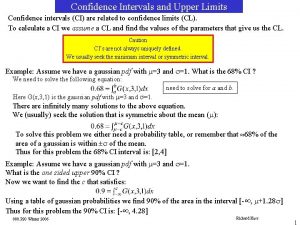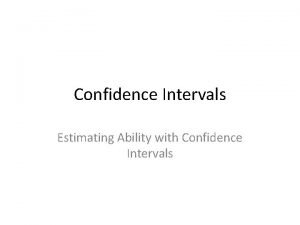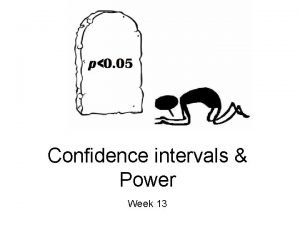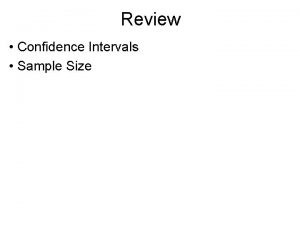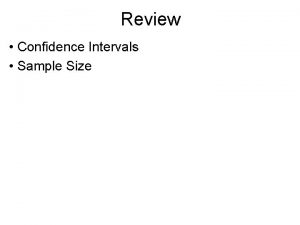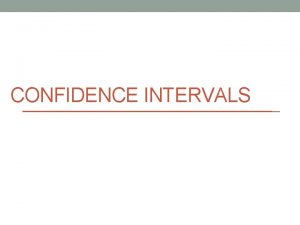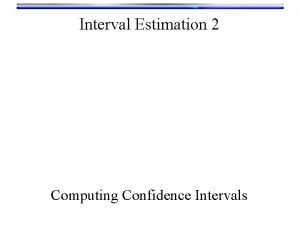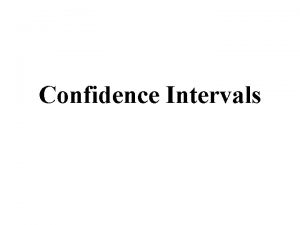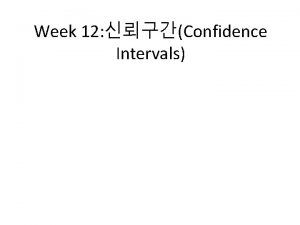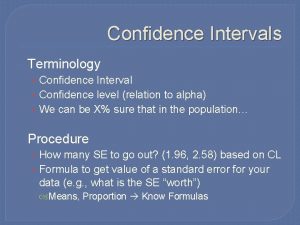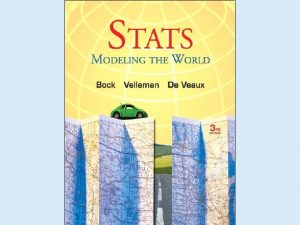Chapter 19 Confidence Intervals for Proportions Copyright 2009


































- Slides: 34


Chapter 19 Confidence Intervals for Proportions Copyright © 2009 Pearson Education, Inc.

Objectives: n The student will be able to: n Construct a confidence interval for a proportion and interpret in the context of the problem, checking the necessary assumptions. n Determine the sample size necessary to produce a certain margin of error. Copyright © 2009 Pearson Education, Inc. Slide 1 - 3

What happens when the actual population parameters are unknowns? n Example: n Your local newspaper polls a random sample of 330 voters, finding 144 who say they will vote “yes” on the upcoming school budget. n What can we say about the actual sentiment of all voters? n This is a question about proportions so we have p^ = 144/330 =. 4364 n We don’t know p Copyright © 2009 Pearson Education, Inc. Slide 1 - 4

Standard Error n Both of the sampling distributions we’ve looked at are Normal. n For proportions n For means Copyright © 2009 Pearson Education, Inc. Slide 1 - 5

Standard Error (cont. ) n n n When we don’t know p or σ, we’re stuck, right? Nope. We will use sample statistics to estimate these population parameters. Whenever we estimate the standard deviation of a sampling distribution, we call it a standard error. Copyright © 2009 Pearson Education, Inc. Slide 1 - 6

Standard Error (cont. ) n For a sample proportion, the standard error is n For the sample mean, the standard error is Copyright © 2009 Pearson Education, Inc. Slide 1 - 7

A Confidence Interval n Recall that the sampling distribution model of is centered at p, with standard deviation . n Since we don’t know p, we can’t find the true standard deviation of the sampling distribution model, so we need to find the standard error: Copyright © 2009 Pearson Education, Inc. Slide 1 - 8

What happens when the actual population parameters are unknowns? n Your local newspaper polls a random sample of 330 voters, finding 144 who say they will vote “yes” on the upcoming school budget. ^ n p = 144/330 =. 4364 n We can compute n n SE(p^) = √(. 4364*(1 -. 4364)/330) = 0. 0273 How is SE(p^) useful? Copyright © 2009 Pearson Education, Inc. Slide 1 - 9

A Confidence Interval (cont. ) n n By the 68 -95 -99. 7% Rule, we know n about 68% of all samples will have ’s within 1 SE of p n about 95% of all samples will have ’s within 2 SEs of p n about 99. 7% of all samples will have ’s within 3 SEs of p We can look at this from ’s point of view… Copyright © 2009 Pearson Education, Inc. Slide 1 - 10

A Confidence Interval (cont. ) n n Consider the 95% level: n There’s a 95% chance that p is no more than 2 SEs away from . n So, if we reach out 2 SEs, we are 95% sure that p will be in that interval. In other words, if we reach out 2 SEs in either direction of , we can be 95% confident that this interval contains the true proportion. This is called a 95% confidence interval. Copyright © 2009 Pearson Education, Inc. Slide 1 - 11

A Confidence Interval (cont. ) Copyright © 2009 Pearson Education, Inc. Slide 1 - 12

What happens when the actual population parameters are unknowns? n Your local newspaper polls a random sample of 330 voters, finding 144 who say they will vote “yes” on the upcoming school budget. ^ n p = 144/330 =. 4364 ^ n SE(p ) = √(. 4364*(1 -. 4364)/330) = 0. 0273 ^ n We can be 95% sure that p falls within 2 SEs of p , so the real p is between (. 4364 -2*. 0273) =. 38 and (. 4364+2*. 0273)=. 49 with 95% confidence. n In other words: We estimate that the support for passing the school budget is between 38% and 49% with 95% confidence. Copyright © 2009 Pearson Education, Inc. Slide 1 - 13

What Does “ 95% Confidence” Really Mean? n n Each confidence interval uses a sample statistic to estimate a population parameter. But, since samples vary, the statistics we use, and thus the confidence intervals we construct, vary as well. Copyright © 2009 Pearson Education, Inc. Slide 1 - 14

What Does “ 95% Confidence” Really Mean? (cont. ) n The figure to the right shows that some of our confidence intervals (from 20 random samples) capture the true proportion (the green horizontal line), while others do not: Copyright © 2009 Pearson Education, Inc. Slide 1 - 15

What Does “ 95% Confidence” Really Mean? (cont. ) n n Our confidence is in the process of constructing the interval, not in any one interval itself. Thus, we expect 95% of all 95% confidence intervals to contain the true parameter that they are estimating. Copyright © 2009 Pearson Education, Inc. Slide 1 - 16

Margin of Error: Certainty vs. Precision n We can claim, with 95% confidence, that the interval contains the true population proportion. n The extent of the interval on either side of is called the margin of error (ME). In general, confidence intervals have the form estimate ± ME. The more confident we want to be, the larger our ME needs to be (makes the interval wider). Copyright © 2009 Pearson Education, Inc. Slide 1 - 17

Margin of Error: Certainty vs. Precision (cont. ) Copyright © 2009 Pearson Education, Inc. Slide 1 - 18

Margin of Error: Certainty vs. Precision (cont. ) n n n To be more confident, we wind up being less precise. n We need more values in our confidence interval to be more certain. Because of this, every confidence interval is a balance between certainty and precision. The tension between certainty and precision is always there. n Fortunately, in most cases we can be both sufficiently certain and sufficiently precise to make useful statements. Copyright © 2009 Pearson Education, Inc. Slide 1 - 19

Margin of Error: Certainty vs. Precision (cont. ) n n n The choice of confidence level is somewhat arbitrary, but keep in mind this tension between certainty and precision when selecting your confidence level. The most commonly chosen confidence levels are 90%, 95%, and 99% (but any percentage can be used). Lets find the cut off z scores (z*) for these percentages… Copyright © 2009 Pearson Education, Inc. Slide 1 - 20

Assumptions and Conditions (cont. ) n n Here are the assumptions and the corresponding conditions you must check before creating a confidence interval for a proportion: Independence Assumption: We first need to Think about whether the Independence Assumption is plausible. It’s not one you can check by looking at the data. Instead, we check two conditions to decide whether independence is reasonable. n Randomization Condition: Were the data sampled at random or generated from a properly randomized experiment? Proper randomization can help ensure independence. n 10% Condition: Is the sample size no more than 10% of the population? Copyright © 2009 Pearson Education, Inc. Slide 1 - 21

Assumptions and Conditions (cont. ) § Sample Size Assumption: The sample needs to be large enough for us to be able to use the CLT. n Success/Failure Condition: We must expect at least 10 “successes” and at least 10 “failures. ” Copyright © 2009 Pearson Education, Inc. Slide 1 - 22

One-Proportion z-Interval n n When the conditions are met, we are ready to find the confidence interval for the population proportion, p. The confidence interval is where n The critical value, z*, depends on the particular confidence level, C, that you specify. Copyright © 2009 Pearson Education, Inc. Slide 1 - 23

Margin of Error & Confidence Interval for a Population Proportion n n The margin of error for a population proportion is given by: The confidence interval for a population proportion is given by: Copyright © 2009 Pearson Education, Inc.

Using the TI for finding a confidence interval for p: 1 -Prop. ZInt n n n A random sample of 416 teenagers showed that 76. 4% of them had experimented with alcohol. What is the 95% confidence interval for the proportion of the population? Stat…Tests…#A for 1 -Prop Zint enter x: number of teenagers that have experimented with alcohol (has to be a whole number…. . . 764*416 which is approximately 318; always go UP to the next whole number) n: 416 C-level: . 95 You should get a confidence interval from 72. 4% to 80. 5%. We are 95% confident that the proportion of teenagers that experimented with alcohol is between 72. 4 and 80. 5 percent. Slide 1 - 25 Copyright © 2009 Pearson Education, Inc.

Example n An experiment finds that 27% of 53 subjects report improvement after using a new medication. Create a 95% confidence interval for the actual cure rate. n First check conditions: randomization condition, 10% condition, success/failure condition n Why is our interval so wide? n Make it narrower – 90% confidence. n What are the advantages and disadvantages? Copyright © 2009 Pearson Education, Inc. Slide 1 - 26

n 8. A poll found that 38% of a random sample of 1012 American adults said that they believe in ghosts. n a. Find the margin of error for this poll if we want 90% confidence in our estimate of American adults who believe in ghosts. n E=0. 025 n b. Explain what a “ 90% confidence interval” means and find the interval. n We can be 90% confident that the true population proportion (i. e. the percentage of American adults who believe in ghosts) is contained in the following CI: (0. 355, 0. 405) n c. If we want to be 99% confident, will the margin of error be larger or smaller? n Larger n d. Find that margin of error. n E=0. 0393 n e. In general, will smaller margins of error involve greater or less confidence in the interval? Slide 1 - 27 Copyright © 2009 Pearson Education, Inc. n Less

n n 9. Direct mail advertisers send solicitations to thousands of potential customers in the hope that some will buy the company’s product. The response rate usually is quite low. Suppose a company wants to test the response to a new flyer and sends it to 1000 people randomly selected from their mailing list of over 200, 000 people. They get 123 orders from the recipients. a. Create a 90% confidence interval for the percentage of people the company contacts who may buy something. n (10. 6%, 14. 0%) b. Explain what the interval means. n We can be 90% confident that the true proportion of the company’s 200, 000 customers who will actually purchase an item is in the above interval. c. The company must decide whether to now do a mass mailing. The mailing won’t be cost effective unless it produces at least a 5% return. What does your confidence interval suggest? n They should do the mass mailing. Copyright © 2009 Pearson Education, Inc. Slide 1 - 28

n n n 10. A national health organization warns that 30% of the middle school students nationwide have been drunk. Concerned, a local health agency randomly and anonymously surveys 110 of the 1212 middle school students in its city. Only 21 of them reported having been drunk. a. What proportion of the sample reported having been drunk? n 21/110 = 0. 191 b. Does this mean that this city’s youth are not drinking as much as the national data would indicate? n Not necessarily – we need to build a confidence interval. c. Create a 95% confidence interval for the proportion of the city’s middle school students who have been drunk. n (11. 7%, 26. 4%) d. Is there any reason to believe that the national level of 30% is not true of the middle school students in this city? n Yes – even the upper bound of the above confidence interval is below 30%. Copyright © 2009 Pearson Education, Inc. Slide 1 - 29

Sample Size Determination for Estimating a Population Proportion n n The margin of error is z*SE(p^)… solving for n we get: where: z* = critical value based on the desired confidence level E = desired margin of error If p^ and q^ are unknown, assume they are both . 5, this is the “worst case scenario” Copyright © 2009 Pearson Education, Inc.

Choosing a sample size n An experiment finds that 27% of 53 subjects report improvement after using a new medication. What sample size would we need in a follow up study if we want a margin of error ± 5% with 98% confidence? n n n Solve for z* of the 98% confidence interval using inv. Norm(. 01) = -2. 33 Recall the formula: Set E =. 05, z=2. 33, use our previous estimates of p^ and q^ and solve for n. Copyright © 2009 Pearson Education, Inc. Slide 1 - 31

Example on choosing a sample size n n 11. In preparing a report on the economy, we need to estimate the percentage of businesses that plan to hire additional employees in the next 60 days. a. How many randomly selected employers must we contact in order to create an estimate in which we are 95% confident with a margin of error of 5%? n 384 b. Suppose we want to reduce the margin of error to 3%. What sample size will suffice? n 1067 c. Why might it not be worth the effort to try to get an interval with a margin of error of only 1%? n Because it would take a sample size of 9, 604. That is a mighty big (i. e. expensive) number. Copyright © 2009 Pearson Education, Inc. Slide 1 - 32

What Can Go Wrong? (cont. ) Violations of Assumptions: n Watch out for biased sampling—keep in mind what you learned in Chapter 12. n Think about independence. Copyright © 2009 Pearson Education, Inc. Slide 1 - 33

Practice problems n Text: 4, 6, 8, 11, 18, 36 and 38 Copyright © 2009 Pearson Education, Inc. Slide 1 - 34
 Critical value for 90 confidence interval
Critical value for 90 confidence interval Chapter 18 confidence intervals for proportions
Chapter 18 confidence intervals for proportions Chapter 19: confidence intervals for proportions
Chapter 19: confidence intervals for proportions Confidence interval for variance
Confidence interval for variance Deveiation
Deveiation Confidence interval vs confidence level
Confidence interval vs confidence level Reporting confidence intervals
Reporting confidence intervals Confidence interval for population mean
Confidence interval for population mean Confidence intervals excel
Confidence intervals excel Preparing to estimate a population proportion
Preparing to estimate a population proportion How to find confidence interval on ti 84
How to find confidence interval on ti 84 Confidence interval minitab
Confidence interval minitab How to add 95 confidence intervals in excel
How to add 95 confidence intervals in excel Confidence interval vs confidence level
Confidence interval vs confidence level 2009 pearson education inc
2009 pearson education inc Copyright international color consortium, 2009
Copyright international color consortium, 2009 Dell all rights reserved copyright 2009
Dell all rights reserved copyright 2009 Copyright 2009 pearson education inc
Copyright 2009 pearson education inc Diffrazione della luce zanichelli
Diffrazione della luce zanichelli Copyright 2009
Copyright 2009 Equilibrio termico zanichelli
Equilibrio termico zanichelli Copyright 2009 pearson education inc
Copyright 2009 pearson education inc Copyright 2009 pearson education inc
Copyright 2009 pearson education inc Copyright 2009 pearson education inc
Copyright 2009 pearson education inc 2009 pearson education inc
2009 pearson education inc Chapter 20 more about tests and intervals
Chapter 20 more about tests and intervals Proportional sides
Proportional sides Chapter 22 comparing two proportions
Chapter 22 comparing two proportions Chapter 20 testing hypotheses about proportions
Chapter 20 testing hypotheses about proportions Chapter 21 comparing two proportions
Chapter 21 comparing two proportions Chapter 19 testing hypotheses about proportions
Chapter 19 testing hypotheses about proportions Geometry chapter 7 proportions and similarity answers
Geometry chapter 7 proportions and similarity answers Chapter 12 inference for proportions answers
Chapter 12 inference for proportions answers Chapter 20 testing hypotheses about proportions
Chapter 20 testing hypotheses about proportions Chapter 22 comparing two proportions
Chapter 22 comparing two proportions
